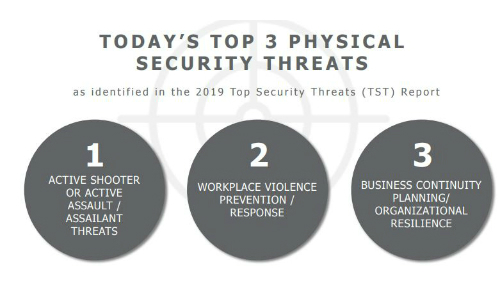Active Shooter Threat Top of Mind for Corporate America, Securitas Finds
“The survey makes clear that major organizations view active shooters as a critical threat,” says Securitas USA COO William Barthelemy.

The “Top Security Threats” survey also revealed that of the 27 threat categories security executives consider to be a concern, 21 may be caused or carried out by company insiders.
PARSIPPANY, N.J. — Active shooters are now the leading physical security threat concerning corporate America, according to a survey released today by Securitas Security Services USA.
Entitled Top Security Threats (TST), the survey also revealed that of the 27 threat categories security executives consider to be a concern, 21 may be caused or carried out by company insiders. As a leading global provider of protective services, Securitas enables companies of all sizes and industries to establish and maintain security programs.
Notably, the threat from active shooters was first identified as a viable concern among security directors in Securitas’ 2016 survey. Previously, it was not considered a top threat by survey respondents from any industry.
Securitas’ biennial TST report reflects the feedback from C-level directors and security managers from Fortune 1,000 companies and organizations responsible for the safety and security of people, property and assets.
The Securitas USA survey has become a defining resource used by security managers for making data-driven security planning decisions, according to a press release.
The top three physical security threats as identified in the Securitas TST survey are:
- Active shooter or active assault/assailant threats;
- Workplace violence prevention/responses;
- Business continuity planning/organizational resilience.
“The survey makes clear that major organizations view active shooters as a critical threat,” says Securitas USA COO William Barthelemy. “We know from our interactions with clients and other industry executives that addressing this issue from all fronts and at all levels is an on-going priority in almost all organizations,” he says.
“While cybersecurity remains a top concern, there are threats to the safety of people and the security of buildings, equipment and other property that may cause considerable, long-lasting harm to an organization, affecting everything from productivity to business continuity,” Barthelemy continues. “The reality is these threats can come from insiders, people typically not thought to be a primary threat.”
Reflecting the growing concern among executive leadership and boards about the potential effects and implications of security, the survey found that corporate governance has shifted, with a 40% increase in the number of security leaders now reporting directly to a CEO or president, compared to the last Securitas TST survey.
“C-suite decision-makers have recognized the need not only for more advanced security, but also for rigorous contingency and business continuity plans,” Barthelemy added.
The most significant change from the previous survey is the ranking of active shooter threats, which jumped from the third- to the second-greatest concern among security leaders. The TST report also includes editorials from security experts, and the active shooter threat is so significant that three of the six editorials are dedicated to the topic:
- Ensuring Business Continuity After an Active Shooter Event; Sandy Cowlie, Director of Global Security and Business Continuity at Principal Financial Group
- Stopping Active Shooters: Bystanders Cannot Merely Stand By; Konrad Motyka, Director of Security at Mercy College
- Active Shooter Threats: Taking Action Before the Violence Starts; Dwayne Gulsby, Securitas Region President
The editorials stress three distinct aspects of dealing with active shooter threats: preparation, response and recovery. In her article, Cowlie notes, “The impact of such an event can leave an everlasting imprint on your organization and the lives of your employees. Your recovery won’t be just about returning to your facility and patching bullet holes — it will be a long process of compassion and healing.”
The other editorials in Securitas’ TST report provide context and counsel about how organizations can protect themselves from security threats and how to recover from a significant incident:
- Designing Safe Schools in Dangerous Times; Randy Atlas, President of Atlas Security
- Hostile Terminations: Blending Security with Empathy; Michael Ainslie, Head of Global Security for Allegis Group
- Business Continuity Plan: Beyond the Basics; William Powers, Director of Facilities at Clark Art Institute
Since the last survey, Securitas has observed a notable increase in security measures undertaken by corporations and organizations, Barthelemy explains. Indeed, industry sources illustrate that aggregate U.S. corporate security spending has risen 5% annually over the last several years.
“We are also witnessing the desire among our clients to develop customized security procedures for employees working in non-traditional environments, such as shared workspaces and locations far from headquarters,” Barthelemy continues. “In response, we are expanding our services for clients looking to establish real-time, incident-specific global alerts and/or check-ins with employees stationed or travelling in high-risk areas.”
Sparks Research, an independent national marketing research firm based in Clemson, S.C., conducted the survey on behalf of Securitas USA.
To request a copy of the entire report, go here.
To get FREE active shooter training from our sister site, Campus Safety, go here.
If you enjoyed this article and want to receive more valuable industry content like this, click here to sign up for our FREE digital newsletters!

Security Is Our Business, Too
For professionals who recommend, buy and install all types of electronic security equipment, a free subscription to Commercial Integrator + Security Sales & Integration is like having a consultant on call. You’ll find an ideal balance of technology and business coverage, with installation tips and techniques for products and updates on how to add to your bottom line.
A FREE subscription to the top resource for security and integration industry will prove to be invaluable.







